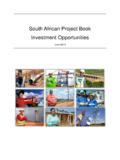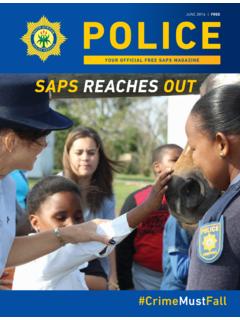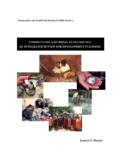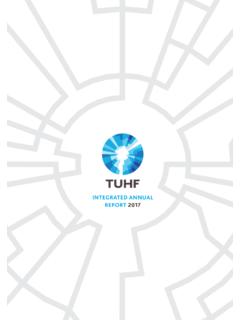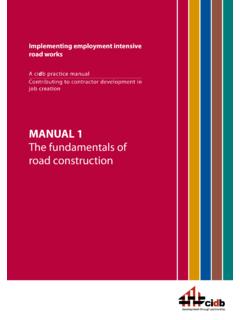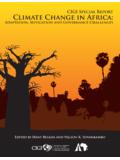Transcription of SMART EVENTS HANDBOOK
1 Greening guidelines for hosting sustainable EVENTS in Cape TownSMART EVENTS HANDBOOK12 Greening guidelines for hosting sustainable EVENTS in Cape TownSMART EVENTS HANDBOOKE ndorsed bySMART EVENTS HANDBOOKP ublished by the City of Cape TownFirst edition June 2010 More information available from:Environmental Resource Management Department7th Floor44 Wale StreetCape Town, 8001 South AfricaTel: 021 487 2284 Fax: 021 487 2578E-mail: City of Cape TownISBN 978-0-9802784-5-3 This book is printed on SAPPI Triple Green paper, an environmentally-friendly paper stock made from chlorine-free sugar cane fibre to support sustainable afforestation in South effort has been made to ensure the accuracy of information in this book at the time ofpublication and to correctly acknowledge photographers. The City of Cape Town accepts noresponsibility for, and will not be liable for, any errors or omissions contained from the Mayor of Cape TownThe 2010 FIFA World CupTM will give Cape Town an opportunity to show the world that it can successfully host major international EVENTS that also leave a positive environmental legacy.
2 To achieve this, Host City Cape Town is implementing Green Goal 2010, the official greening programme of the development of the SMART EVENTS HANDBOOK is one of the Green Goal legacies, which will provide guidance to the EVENTS industry for hosting EVENTS in a more sustainable manner. EVENTS draw people, who need transport and accommodation that leads to economic growth. EVENTS do however also require resources such as energy and water, while creating waste and pollution. As much as we need EVENTS in Cape Town, we also need these EVENTS to be hosted greening is the process of incorporating socially and environmentally responsible decision-making into the organisation, implementation and participation of an event. Regardless of the size or type of event, you can make a difference to ensure that it is done in a responsible manner. We host many large and small EVENTS in Cape Town every year and I would encourage you to consider how you can incorporate event greening as you plan your next s work together to ensure that all Cape Town EVENTS become green PlatoExecutive Mayor WHO SHOULD USE THIS BOOK 1 HOW TO USE THIS BOOK 1 INTRODUCTION 2 WHAT IS EVENT GREENING?
3 3 INTRODUCTION TO EVENT GREENING 3 GREENING PRACTICES 5 Eco-procurement 6 Waste minimisation and management 9 Water conservation 12 Energy efficiency 13 Emissions reduction 15 Biodiversity conservation 17 Social and economic development 18 WHY IS EVENT GREENING IMPORTANT? 19 WHAT ARE THE BENEFITS OF EVENT GREENING? 19 WHAT ARE THE ENVIRONMENTAL IMPACTS OF EVENTS ? 20 What are climate change, global warming and greenhouse gases (GHGs)? 20 What are the causes? 21 What are the consequences? 21 WHAT IS THE INDUSTRY S INVOLVEMENT AND RESPONSIBILITY 22 HOW TO IMPLEMENT EVENT GREENING 25 GETTING STARTED 25 MANAGEMENT PROCESS 26 Preparation - Set up green team, and identify champions 26 Planning - Greening policy, principles, strategy and action plan 27 Implementation - Communication, participation and awareness raising 28 Monitoring and evaluation 29 Leaving a positive legacy 30 HIGH-IMPACT AREAS FOR GREENING INTERVENTIONS 31 Venues and accommodation 32 Food and beverages 36 Exhibitions 38 Marketing, PR and production 40 Transport 41 General 43 WHEN SHOULD AN EVENT-GREENING EXPERT BE HIRED?
4 47 RESOURCES 48 GLOSSARY 48 WEBSITES 51 CONTENTSThis HANDBOOK was developed on behalf of the City of Cape Town by Steadfast Greening with design by Joom Design a HANDBOOK of this nature requires research, comment and advice from a variety of sources. We acknowledge with thanks all who have contributed to the information contained in this HANDBOOK : Cape Town International Convention Centre (CTICC) - Dirk Elzinga and Shaheen Jutzen City of Cape Town - Environmental Resource Management, Communication, Economic Development, Electricity, Solid Waste, and Water and Sanitation Departments Expo Promotions - Anita Peterson Karin Diederichs & Associates - Karin Diederichs Scan Display - Justin Hawes Steadfast Greening - Grace Stead Vineyard Hotel & Spa - Robyn van and many other individuals from the meetings, incentives, conference and EVENTS industry who attended the workshops and provided valuable input.
5 The following organisations have provided valuable input, as well as formal endorsement of this HANDBOOK : Certified Meeting Professional (CMP) Network South Africa Event Greening Forum Exhibition & Event Association of Southern Africa (EXSA) Federated Hospitality Association of Southern Africa (FEDHASA) International Festivals and EVENTS Association Africa (IFEA) Services SETA Southern African Association for the Conference Industry (SAACI) Technical Production Services Association (TPSA)Thank you to individuals and organisations that provided images, with special recognition to:ACKNOWLEDGEMENTS African Agenda Conference Design & Management CTICC Cycle Cabs Derek Main Photography Enchantrix Green Building Council of South Africa (GBCSA) Green Home Heath Nash Design Intelligent Marketing Joom Design Learn to Earn Olly Molly Steadfast Greening The Green Cab Twine Fabrics Vineyard Hotel & Spa Wiehahn Diederichs12 INTRODUCTIONThe SMART Living HANDBOOK was developed for Cape Town households, with a focus on the efficient use of natural resources such as water and energy, the reduction of waste, and the protection of our natural biodiversity.
6 It has been successfully used to train and raise awareness among City of Cape Town staff, in schools, communitiesand the corporate sector in Cape Town. As part of the 2010 FIFA World Cup Cape Town Green Goal Initiative, the Cityof Cape Town decided to also compile a SMART EVENTS HANDBOOK to guide event organisers, venues, suppliers and sub-contractors in planning and implementingevents in a sustainable and responsible manner. It aims to promote resourceefficiency and sustainability in every organised event in Cape Town. The SMART EVENTS HANDBOOK has been produced by the City of Cape Town to encourage event greening for all EVENTS hosted in the city. It can be used for a range of EVENTS , such as meetings, conferences and exhibitions, and applies equally to large sports EVENTS and small local community HANDBOOK is aimed at the following main groups:Event organisers conferences, meetings, seminars, workshops, festivals, exhibitionsVenues hotels, convention centres, and other venues where EVENTS are heldSuppliers and sub-contractors infrastructure, audiovisual equipment, transport, productsHowever, the HANDBOOK is not intended for professional event organisers only, but also for people arranging small informal EVENTS at schools or in their local community.
7 It provides an overview of the main aspects that need to be considered, though innovation continues to broaden the book is divided into four sections with practical tips for implementation:WHAT? Basic information about event-greening principles and practicesWHY? Benefits of event greening, and the environmental impact of eventsHOW? Practical information on how to get started, and what you need to considerRESOURCES: Additional information, with a glossary and useful websitesEvents can have a large environmental impact and therefore it is important to understand the basic principlesand reasons why we need to change our actions. This needs to become an integral part of our planning andimplementation at a micro level, but we also need to understand the bigger picture and an event s relation to global is advisable that this HANDBOOK be read together with the SMART Living HANDBOOK and the SMART Office Hand-book for more detailed information.
8 The SMART Living HANDBOOK can be downloaded from the City of Cape Town website, SHOULD USE THIS BOOKHOW TO USE THIS BOOK43 Event greening is the process of incorporating socially and environmentally responsible decision making into the planning, organisation and implementation of, and participation in, an event. It involves including sustainable development principles and practices in all levels of event organisation, and aims to ensure that an event is hosted responsibly. It represents the total package of interventions at an event, and needs to be done in an integrated manner. Event greening should start at the inception of the project, and should involve all the key role players, such as clients, organisers, venues, sub-contractors and terms event greening and green used in this document refer to responsible, sustainable decision making and implementation, taking note of environmental, social and economic factors.
9 If an event is hosted in a green manner, the anticipated outcomes are as follows: To improve the resource efficiency of the entire event and supply chain management To reduce negative environmental impacts, such as carbon emissions, waste to landfill, and the effect on biodiversity To increase economic, social and environmental benefits (triple bottom-line) To enhance the economic impact, such as local investment and long-term viability To strengthen the social impact, such as community involvement and fair employment To improve sustainable performance within an available budget To present opportunities for more efficient planning and use of equipment and infrastructure To reduce the negative impact on local inhabitants To protect the local biodiversity, water and soil resources To apply the principles of eco-procurement of goods and services To raise awareness of sustainability issues among all role players To ensure that the aims and objectives are clearly defined and measuredGreening an event involves incorporating a combination of the following.
10 Environmental best practice Social and economic development Education on, and awareness of, sustainability issues Monitoring, evaluation and reporting on the event-greening initiatives Leaving a positive legacyThe first time that environmental concerns were raised by the public was at the 1992 Albertville Winter Olympics in France, which led to the first green Games in Lillehammer, Norway, in 1994. The standard was set in 2000 with the Sydney Olympics, and since then, other major sports EVENTS have also considered their environmental impact. During the 2006 FIFA World CupTM in Germany, Green Goal was launched, which is also being implemented in South Africa for the 2010 FIFA World focus has however not just been on sports EVENTS . The greening of the World Summit on Sustainable Development (WSSD) held in Johannesburg in 2002 set new benchmarks for South Africa.
